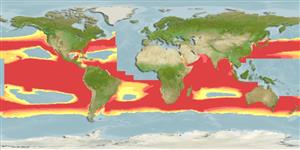Preferred temperature (Referencia
123201): 14.1 - 27.5, mean 23 °C (based on 1102 cells).
Phylogenetic diversity index (Referencia
82804): PD
50 = 0.5352 [Uniqueness, from 0.5 = low to 2.0 = high].
Bayesian length-weight: a=0.00257 (0.00110 - 0.00600), b=3.17 (2.96 - 3.38), in cm total length, based on LWR estimates for this (Sub)family-body shape (Ref.
93245).
Nivel trófico (Referencia
69278): 3.5 ±0.4 se; based on size and trophs of closest relatives
Resiliencia (Referencia
120179): Medio, población duplicada en un tiempo mínimo de 1.4-4.4 años (Assuming Fec < 10,000).
Fishing Vulnerability (Ref.
59153): Moderate to high vulnerability (50 of 100).
🛈
Nutrients (Ref.
124155): Calcium = 77.4 [43.7, 128.9] mg/100g; Iron = 1.41 [0.88, 2.24] mg/100g; Protein = 18.9 [17.8, 19.9] %; Omega3 = 0.201 [0.111, 0.358] g/100g; Selenium = 28.8 [15.3, 56.4] μg/100g; VitaminA = 10.4 [3.5, 32.6] μg/100g; Zinc = 0.79 [0.57, 1.10] mg/100g (wet weight);
